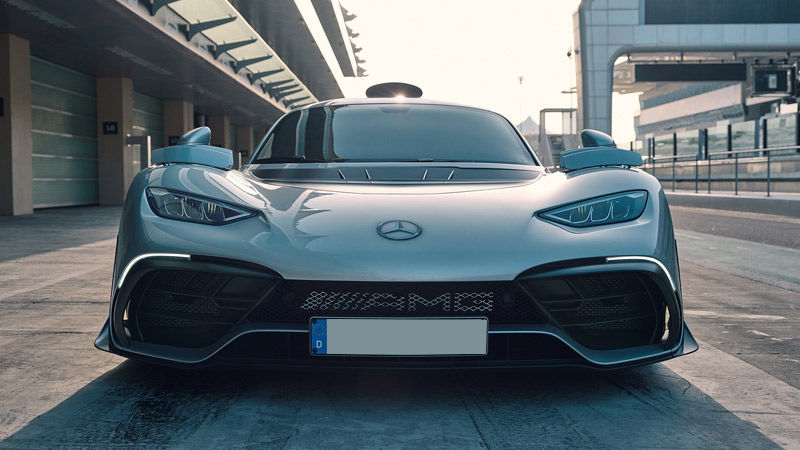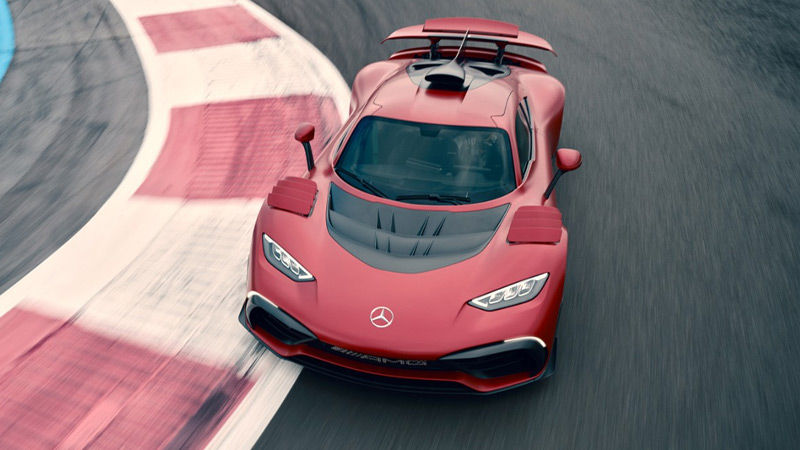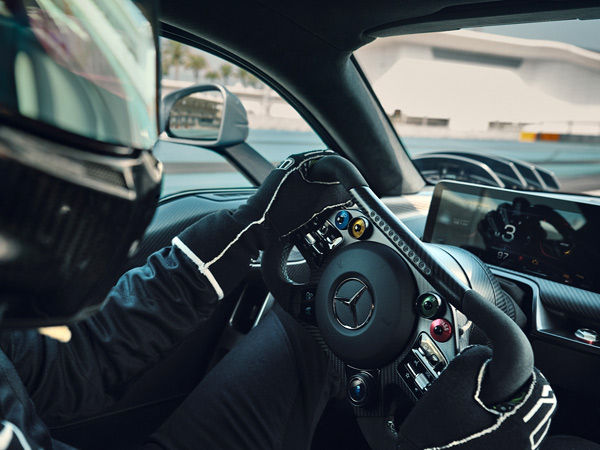The death of AMG’s hugely ambitious One hypercar was greatly exaggerated. The Mercedes AMG One has arrived after multiple delays and communications blackouts. And we now have new images of the final hybrid hypercar.

AMG hasn’t offered any explanations for the car’s lengthy development. However, the pandemic is undoubtedly to blame, as is the horrifyingly complicated engineering challenge that the car’s powertrain represents.
After years of anticipation, the Mercedes AMG One is here — a car that genuinely brings F1 technology to the road.
Although it was supposed to enter the roads in 2021, technological issues have kept it from occurring until now. That’s hardly unexpected given that the One, formerly known as the Project One, is powered by the same 1.6-liter turbo V6 Mercedes used in Lewis Hamilton’s Formula One vehicle.
Engineers have dreamed about bringing the ultimate technology to the streets since the inception of Formula 1. For the first time, the two-seater Mercedes AMG Project ONE will transfer the most advanced and economical Formula 1 hybrid technology from the track to the street practically one to one. The performance hybrid will have over 1,000 horsepower and a top speed of more than 350 km/h. The Mercedes-AMG Project ONE will combine breathtaking racing performance with practical Formula 1 hybrid technology and exceptional economy. It is not just a homage to our racing accomplishments but also a bold statement about our path to the ‘Future of Driving Performance.’
An F1 engine is a tiny capacity engine with many cylinders. Every engine component is built to handle extreme stress, strain, speed, forces, and temperatures. An F1 engine is only required to travel around 300 kilometers in seven races. So, in theory, an F1 engine is meant to endure just 3,000 kilometers, including qualifying and practice laps. The engine of a production car meant for the road typically lasts 100X longer in some circumstances.

Mercedes AMG One Hypercar 2023
First and foremost, the Mercedes AMG One is road legal. It is propelled by a hybrid system that includes an F1-derived 1.6L V6 engine. Its engine features a single turbo with electronic aid and a redline of 11,000 rpm. The engine alone produces 566 horsepower while satisfying Euro-6 pollution regulations and is mated to a 7-speed automated transmission.
The Mercedes AMG One’s sophisticated engine has frequently delayed the car as engineers strive to make it meet emissions requirements. The V6 has two injection systems. The additional port injection is required to meet exhaust pollution standards while maintaining the engine’s exceptionally high specific output.

The hybrid system comprises four electric motors and an 8.4 kWh battery with an advanced cooling system—two of the four motors power each of the front wheels, totaling 322 horsepower. The third motor is connected to the crankshaft and provides 161 horsepower. In contrast, the fourth motor is connected to the complicated and cutting-edge turbocharger, which adds 121 bhp to the hypercar’s astonishing 1049 overall bhp output. It can go 18 kilometers on electric power alone.
The Mercedes AMG One is built on a carbon-fiber monocoque chassis with an F1-style pushrod suspension that also functions as a sway bar. It increases the car’s stiffness and reduces chassis flex, making the hypercar a fantastic track machine. It also has front 15.6″ carbon-ceramic brakes with 6-piston callipers and rear 15″ carbon-ceramic brakes with 4-piston calipers.
The Michelin Pilot Sport Cup 2 M01 tires are built exclusively for the 2023 Mercedes AMG One. They are mounted on 9-spoke forged magnesium wheels. Even though Mercedes hasn’t disclosed the downforce and harmful lift data, we can infer it’s exceptionally aerodynamic based on the bodywork and the enormous scoop and wing at the back. It can accelerate from 0 to 100 kph in 2.9 seconds, 0 to 200 kph in 7 seconds, and max out at 352 kph.
It’s amazing how well all of these pieces fit together. Aside from the V6, which can achieve 11,000 rpm, the front electric motors can reach rotor rotations of up to 50,000 rpm. The throttle response is reported to be even greater than that of a normally aspirated V8, with the motor housed within the turbo removing any latency. The completely electric front axle allows for separate braking or acceleration of each front wheel, increasing dynamism.

The high-performance battery, with a capacity of only 8.4 kWh, is an essential element of the equation. F1 is also used in the lithium-ion energy storage system, which has an innovative cooling system and an 800-volt design to minimize cable diameters. It conserves both space and weight.
Also Read, F1 Car 101: Everything you Need to Learn about Formula 1
Battery Life, Range, And Charging
An all-electric range of about 11 miles isn’t much, but it’s a first in the hypercar world. Mercedes estimates that the Mercedes AMG ONE will have a combined weighted fuel consumption number of 8.7 liters per 100 kilometers, equating to roughly 27 mpg. The EPA ratings should be lower, but they will never be released because the AMG One will not be available in the United States. Still, over 25 mpg for a hypercar with this much power is a huge accomplishment.
The battery is charged using an alternating current and the 3.7 kW onboard charger. The battery is also charged by the engine or by recuperation energy. The carmaker provided no charging times.
Mercedes AMG One Cargo Interior

From behind the wheel, no other Mercedes feels as close to an F1 machine as this One. The interior of the Mercedes AMG One swaps luxury for an exotic, sporty cabin centered on the driver. One passenger can sit beside the driver in the Mercedes AMG One’s bucket seats, built into the monocoque. The flattened top and bottom parts of the F1-style steering wheel stand out, and it is loaded with settings for the driving modes and suspension. The most important information is shown on two 10-inch displays, one in the middle tilted in the driver’s direction.
In terms of materials, the seats with the interior are completed in black Dinamica microfiber, which will keep occupants in place. Nappa leather trim and carbon fiber door panels round off the design. The AMG Motorsport seat pans may be changed to a 25 or 30-degree angle. The steering wheel is electrically adjustable, and the pedal box has eleven different settings. Even the passenger footrest may be adjusted separately.
The inside of the Mercedes AMG One is mainly black, with Magma Grey seat inserts and yellow contrast topstitching brightening things up. It’s unclear how much personalization those 275 lucky clients will get. However, the manufacturer did suggest various colors are available.

Mercedes-AMG chose not to employ a typical rearview mirror due to the vertical rear wing’s influence on hindsight. Instead, the ONE has a MirrorCam in the rear that displays real-time imagery.
While the cargo capacity in the Mercedes AMG One will not be a worry for anybody purchasing this vehicle, there are storage compartments beneath the seats for storing odds and ends and a central box for a fire extinguisher.
Pricing and Launch
The automobile is also quite attractive. The design is crisp and edgy, with just the right attitude. The butterfly doors add to the spectacle. The car even has carbon fiber and leather-clad seats and interiors. It has two upright 10″ displays for various tasks on the interior and an F1-inspired rectangular steering wheel.
The automobile costs $2.72 million, nearly Rs. 21 crores without import charges and taxes. Only 275 Mercedes AMG One hypercar will be produced, and almost all have already been reserved. How many of the 275 units will make it to Indian beaches is unknown.

Extremists such as the Koenigsegg Regera, a manic hybrid, will be competitors. Although the Bugatti Chiron Pur Sport costs more, this is more of a comfy GT that cannot compete with the Mercedes AMG One’s agility on the track.
